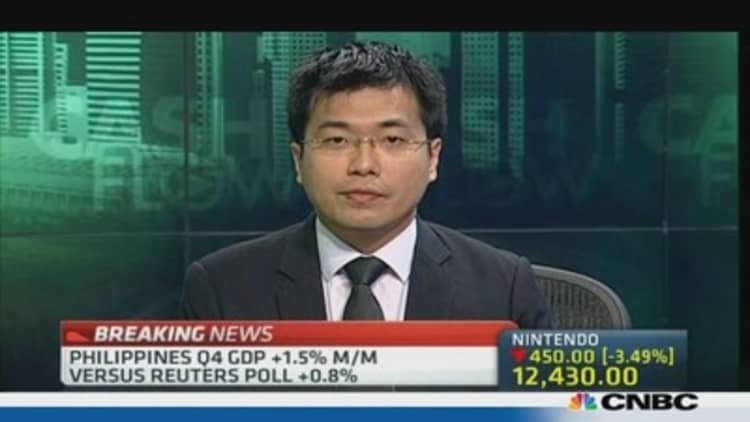Emerging markets may be coming under the cosh, but there are five reasons to be positive on the Philippines, according to Capital Economics.
"The Philippines' economy came through the disruption caused by Typhoon Haiyan reasonably well, posting healthy growth in the final quarter of 2013," Gareth Leather, an economist at Capital Economics, said in a note, adding he sees five reasons to believe the longer-term prospects are bright.
(Read more: Show me the Monet: Philippines seeks return of Marcos paintings)
The Philippines gross domestic product, or GDP, for the fourth quarter grew 6.5 percent from a year earlier, beating expectations for around 6.0 percent, according to a Reuters poll. The data suggest the economic hit from the devastating typhoon Haiyan, which struck in November, wasn't as bad as feared.
The first reason the country's outlook is likely to be bright is that it faces less risk of an external crisis as it has run a current account surplus for every year since 2003 and its foreign-exchange reserves are up five-fold since then, Leather said.
(Read more: As Philippines rebuilds, family overseas will play a key role)
"The large current account surplus, and the resulting lack of dependence on foreign financing, limits the country's vulnerability to sudden capital outflows," he said, noting the market was relatively unscathed in last year's emerging market turbulence.

The country's improving fiscal position is another positive, the note said, with the debt-to-GDP ratio falling to less than 40 percent from its peak of 70 percent in 2003.
Not only does this mean the chances of a sovereign debt crisis are diminished, with the country now rated at investment grade by the three main ratings agencies, but less money is also being spent on debt repayment, Leather said.
"The government has more resources to spend on infrastructure, education and healthcare, which can raise productivity and drive long-run growth," he said.
(Read more: )
A third positive is the archipelago's "demographic sweet spot," he said. While many regional countries, such as South Korea, face an aging population and declining workforce, the Philippines' working-age population is expected to rise by over 40 percent from 2010-2030, Leather said.
In addition to boosting the economy's productive potential, as the number of dependents relative to workers falls, the savings rate should rise, supporting investment and boosting long-term per capita growth, Leather said.

The reform-minded government has been another positive, offering significant improvement to the business environment with moves including public-private initiatives on infrastructure and a crackdown on corruption, Leather said.
The fifth reason is progress in developing a competitive manufacturing sector, which has been a key route to development for emerging Asian economies, he said.
"A high level of spoken English, plenty of young workers, low labor costs, as well as rising labor costs in China mean the Philippines is better placed now than it has been for a very long time," Leather said.
(Read more: Who will pay the price for the emerging market mess?)
To be sure, Leather has some cautions on the outlook, particularly about who will replace President Benigno Aquino at the end of his term in 2016, citing a danger he will be followed by a weak, corrupt or incompetent leader.
Additionally, positives for the economy may not translate into gains for investors. Philippine shares are already trading at 17.7 times earnings, a more than 22 percent premium to their long-term average of 14.4 times, according to Nomura.
—By CNBC.Com's Leslie Shaffer; Follow her on Twitter @LeslieShaffer1

